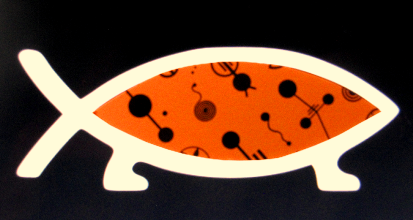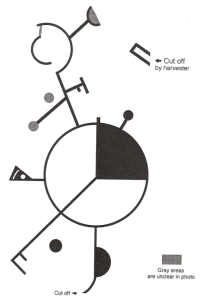Crop circle communication is a process replete with symbols, riddles, and metaphor. Multiple possible meanings radiate from the shape and context of each circle, as well as through synchronicities of events, locations, and even unspoken thoughts.
By mapping seemingly-isolated formations and their associated synchronicities, the resultant geographies bring out meanings previously hidden in uncharted territory, affording us radical new insights into the language of the crop circles – and thereby the true nature of the phenomenon.
The map I’ll be explicating here is infused with evidence of what I call the Other Intelligence.
As Crop Circles Speak, the Map Speaks
We apply filters to just about everything we perceive. A cacophony of many voices falls away, for instance, when we hear our name spoken in a crowd; similarly, the meaning we derive from a crop circle is ours uniquely. But curiously, the alignments map instead met me with an agenda of its own – no external filter needed.
That a map like this would fall together in this way is unlikely, so acknowledging the alternative – that these elements have been shared with us this way, on purpose, by an intelligence we’ve yet to identify – is critical. With that acknowledgement comes the responsibility to listen. Listen.
The interpretation of the signal is, of course, a subjective task: I present it as I see it, and I encourage others to explore the territory by clicking on interactive map and reading the articles linked in the narrative. But again, at the most basic level, simply listen and the clues themselves will highlight messages encoded in the transmission.
The Origin of the Alignments Map
View Crop Circle Alignments (Original Map) in a larger map
The Topeka-Inman-Plevna line tipped me off about the Other Intelligence: the Inman formation appeared when wished for, and on a line that would eventually connect to the location where I later learned about it. In short, the place points on the TIP line are out of time-order, speaking to the relatively omniscient nature of the Other Intelligence.
Some measure of choice is necessary, both to provide a context and to help guide interpretation. I select Inman KS, Langdon ND, and Teton ID to anchor this map specifically because of each formation’s relative importance to me personally. The resulting triangle, along with the parallel TIP line, provides a visual hook – an element of design that resonates with the pleasing geometries of the crop circles themselves. Surely this map similarly contains messages awaiting discovery; I’m drawn in and begin exploring.
The triangle’s center highlights a vast and beautiful landscape, the Badlands of South Dakota, sacred to the indigenous people of the region. Specifically, the center is over Stronghold Table, or Onagazi – site of the the Lakota Ghost Dance in 1890 that eventually led to the Massacre at Wounded Knee.
As I look closer, a Native American theme continues to emerge. I learn that Teton is another word for Lakota – as in Lakota Sioux, who have especially strong ties to the Badlands.
I find Bear Butte on the line from the Inman circle through the center of the triangle (the Inman-Center line). Bear Butte rises almost a quarter of a mile above the surrounding plains. Here the Lakota and other tribes commune with Wakan Tanka, the Great Spirit, the central spiritual link connecting us with all of nature.
Black Elk said Wakan Tanka hears us even when we speak softly, which corresponds directly to crop circle phenomena, where private wishes and questions often elicit a response from the Other Intelligence. Bear Butte thus echoes an important theme of this map: “Communication with an Other Intelligence.”
The Teton-Center line eventually arrives at Spirit Lake, Iowa, site of an 1857 massacre in which white settlers were killed by a band of Santee Sioux in a backlash against the theft of their native land and broken treaties. In a double synchronicity, the Langdon-Center line also crosses the Spirit Lake Sioux reservation on the southern shores of Devils Lake. I’m hearing, “Beware of the modern materialistic life that severs our link with the natural world.”
The Watertown SD crop circle of 1996, reached by extending a line from a point 1/4 of the way from Teton to Inman through the center of the triangle, virtually shouts intentional design embedded in the map. Specific elements built into the complex visual form of this crop circle refer to Kokopelli, a trickster figure associated with fertility and agriculture. The trickster is a shapeshifter who enchants and encourages us – just as crop circles themselves do. Here the message reads, “Pay attention, and have fun.”
figure associated with fertility and agriculture. The trickster is a shapeshifter who enchants and encourages us – just as crop circles themselves do. Here the message reads, “Pay attention, and have fun.”
As the import of the Lakota theme was reinforced time and time again, I experienced an epiphany relating to the cloud circle of 1998, which presented my friend Ron and me with an immediate, direct, and lucid response to a private conversation. Grandfather Sky is Wakan Tanka, is the Great Spirit, and is indeed responsive to our very thoughts and wishes, as Black Elk reminded us. I have yet to explore any clues that may arise from the cloud circle’s place point on the map, but that experience is now quite clearly a resonant thread in the map’s theme. I am reminded of the co-creative nature of crop circles.
Other ties to the tribal theme are found in associated synchronicities that I’ve not detailed here yet, including one related to the discovery of the remains of a medicine wheel in central Kansas during a plane flight in search of crop circles. I’m also researching a Lakota connection to the star people of the Pleiades, and a possible tie with the numerous Pleiadean-themed synchronicities that accompanied my first crop circle experience.
More Alignments and Number Synchronicities
Aside from the Lakota theme, other clues and insights inform the map. Synchronicities and alignments are deftly interwoven here, each one turning up the volume of this conversation with the Other Intelligence:
· In a close correspondence, the total area of Kansas (82,282 square miles), my home state and the place I was introduced to crop circles at the Inman crop circle in 1995, comprise almost precisely 1/3 of the total area of the triangle (246,815 square miles). The 31 square mile discrepancy is negligible in the overall dimensions of the map. I take note of “one-third” as a potential message here.
· In another very close correspondence, on the Topeka-Inman-Plevna line, the Inman crop circle appears 39.86 miles from Plevna – almost exactly 1/4 of the 159 miles from Plevna to Topeka. Add “one-fourth” to the clues.
· Plevna, Montana, sharing a rare place name with Plevna, Kansas of the T-I-P line, appears in the vicinity of where the Inman-Center line connects with the Langdon-Teton line. This synchronicity, though of a smaller magnitude than the others described here, undoubtedly adds resonance to the map. Here I’m reading, “Home,” as Plevna is where I spent a good many years of my youth, and is still where I go home to when I visit Kansas.
· The Inman-Teton line passes fellow UFO and ET experiencer Mike Clelland’s residence at a distance of less than two miles – which is a doubly remarkable coincidence since Mike, like myself and many others, desired a crop circle encounter and directly received a formation in response. The message here once again echoes Black Elk’s reminder that the Great Spirit hears and responds even to our whispers.
· And if all of that were not enough, the Langdon-Center line eventually skirts the western edge of Boulder, Colorado – where I currently reside. I’m hearing two things here: “Culmination,” and “Be here now.” With this correspondence, I sense that the alignments map and all within it have come full circle, so to speak, and reflects the tribal wisdom that all things are created in a circle. While I’m grounded in Boulder, I’m being called to explore the Badlands, climb Bear Butte, and meet with the Lakota.
What Does All of This Mean?
The facts of the map speak for themselves, and it’s up to us to interpret what is being said.
Since the map’s order and meaning arise directly from the overlay of meaningful correspondences tied to relevant points widely separated in time and space, I can only conclude that this map’s designer possesses a relative omniscience. The Other Intelligence wants to speak with us, and it’s no small talk – this is important stuff, and it’s ours to explore. Ultimately, the communication is what we make of it.
To me, the importance of honouring tribal wisdom is integral to the meaning of the alignments map. The Lakota and other indigenous peoples have honoured Earth and all creation through a way of life that’s deeply reverent of nature and spirit. The fragmentation of a people starts and ends with conformity to a way of life devoid of nature and short on respect, such as we see resulting from modern technologies that disconnect us from one another and from our life source. Wholeness can be regained by deliberately reconnecting with the natural and the spirit world through time-honoured ritual, respect, reverence, and gratitude – all of which are missing or minimised in the modern lifestyle.
The original Lakota way of life, now in jeopardy, is in alignment with the crop circle phenomenon, where meanings aren’t dictated by force or violence, but rather are communicated through patient guidance, a respect for individuality, and an emphasis on the natural world. Crop circles aren’t imposing anything; they aren’t out to hurt anyone or pollute the environment.
With gratitude to the Other Intelligence, I carry on this conversation.
IMPORTANT NOTE: If you are new to Flat-Map Alignments, please see FMAs: FAQs.
STACE TUSSEL COLLIGAN


